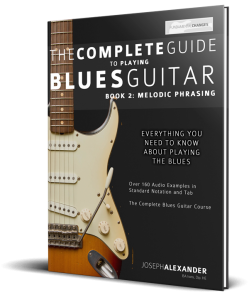Click here to add your own text
Creativity with Question and Answer Structures
In blues guitar, great importance is placed on phrase structure and keeping a musical dialogue running between each successive line. The easiest way to explain this dialogue is with the concept of ‘question and answer phrasing’ or ‘call and response’. In the early spiritual music I referenced in the introduction this is easy to hear. The first phrase is a call and sets up the response. This structure continues throughout the whole piece of music.
For a slightly more up to date and ‘guitarry’ illustration listen to the guitar solo in Stevie Ray Vaughan’s Lenny The whole thing is packed with this call and response idea. Even though both the call and the response are both played on the same instrument there are definitely echoes of the early gospel blues phrasing structure. B.B. King is another great exponent of this idea.
Practicing call and response by yourself can be a little challenging so if you can work on the following ideas with a musician friend you might find them a little more beneficial.
In this first set of exercises I will give you a set lick as a question and you will be providing an answering phrase.
Begin by getting very familiar with the following lick.
Example 4a:

The line in the previous example is going to be your question phrase and will form a repeating figure throughout the 12 bar blues. Notice that it begins on beat two of the bar.
The first exercise is to play this lick in every alternate bar (bars one, three five, etc.) and improvise your own answering phrase in the gaps in bars two, four, six, etc.
The ‘scheme’ of your solo will look like this:
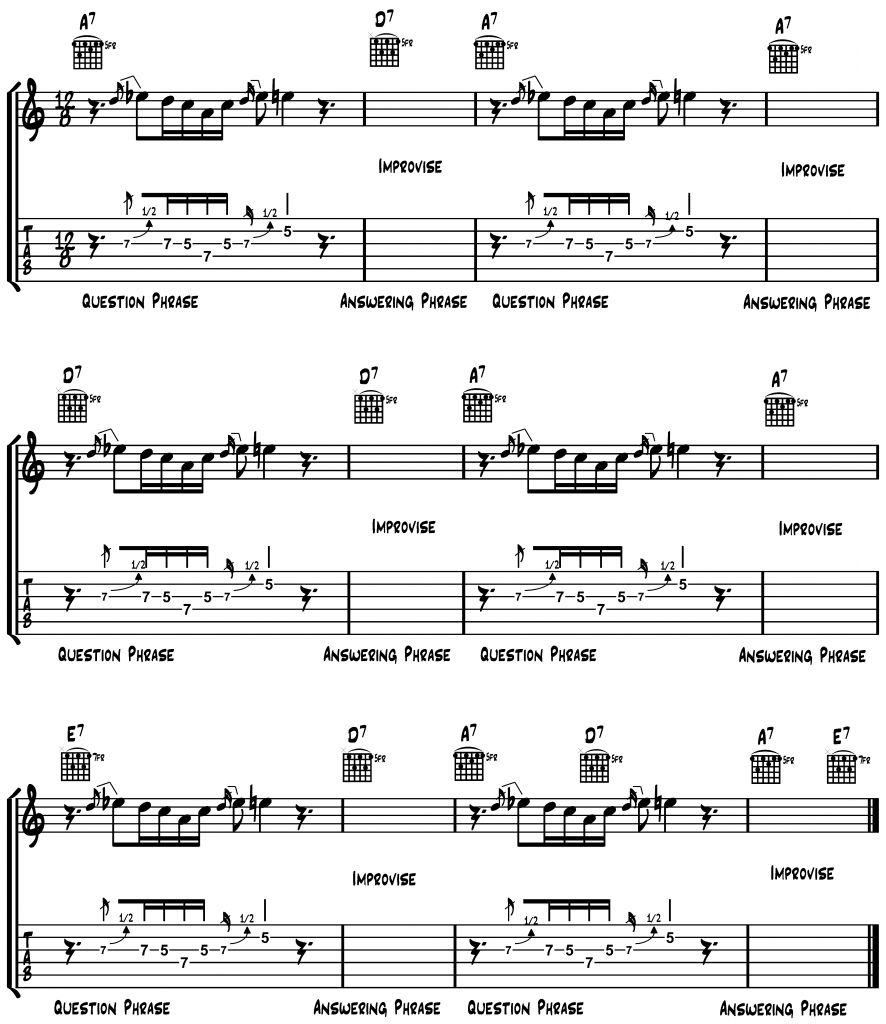
The first exercise is to improvise any answering phrase you wish, with the only rule being that you must be ready to play the question phrase when it reoccurs in the following bar.
Again, there are no wrong answers to this exercise. Here is one of the infinite number of possibilities that I came up for this exercise.
Example 4b:
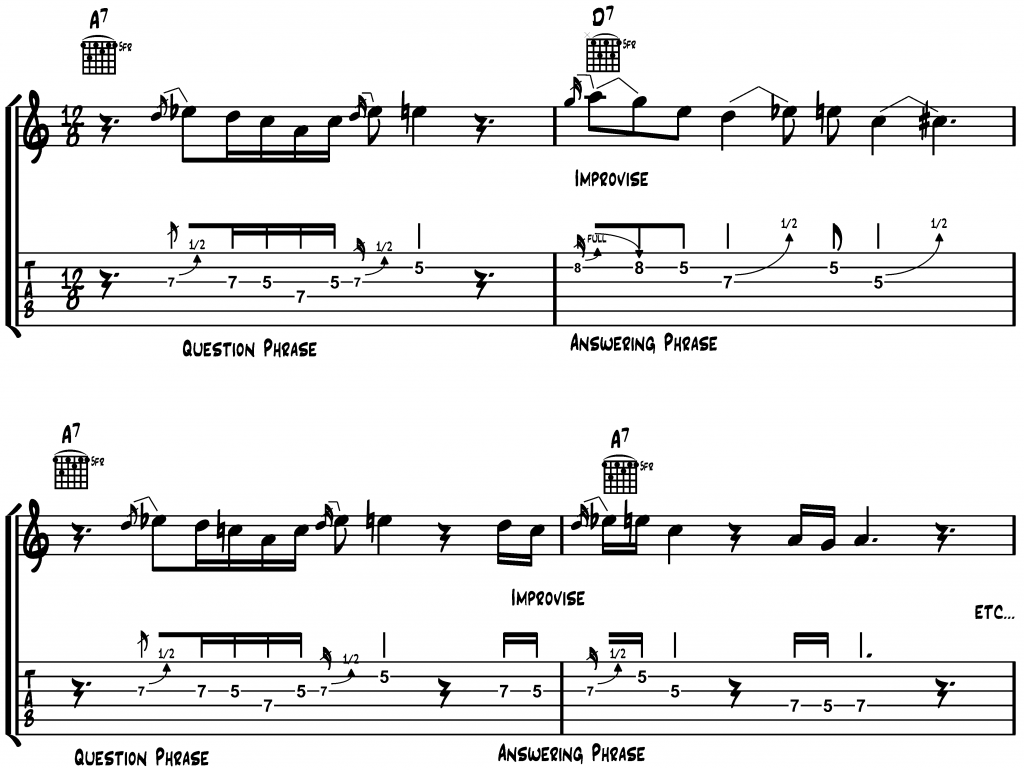
Try to play as many choruses of blues as you can, and find many answers to the exact same question phrase each time. By having to answer the same question in many different ways you will force yourself to become more creative in your answers. You will start to see your solo as one story full of connected ideas rather than just a series of short random ideas.
Even in this seemingly restrictive exercise I am still really giving you ‘free rein’ to fill in the answers as you please. You are simply being told to ‘feel’ what should come next with very little in the way of limitations or structure.
In one sense, this is good because it will help you develop your own voice on the guitar, however in another sense, playing this freely is a little limited as a learning exercise because I’m not forcing you to play too far outside of your comfort zone.
In my life I have been fortunate enough to have some exceptional guitar teachers, and one sentence from Shaun Baxter has always stuck with me:
“It’s a paradox; but the more you limit yourself, the more creative you are forced to become”.
An analogy could be that if I sat you in a restaurant, you’re not going to have to think too much about how to find food, but if I dropped you in a desert you would have to get pretty imaginative about finding your next meal. You may even do things that you never thought you were capable of to find sustenance.
With exercises designed to enhance creativity I firmly believe that if we are to find new ways to play our notes we have to isolate one very small creative aspect at a time and try to exhaust its possibilities before we move on.
Creativity by Limiting Rhythm
Let’s look at some ways we can force ourselves to play something new within the above question and answer structure.
The first thing we can try is to create our answer with exactly the same rhythm as the question. This requires strict discipline and will quickly show us when our fingers, not our ears, try to take control of the guitar.
Here is just one example of using the same rhythm in the answering phrase.
Example 4c:
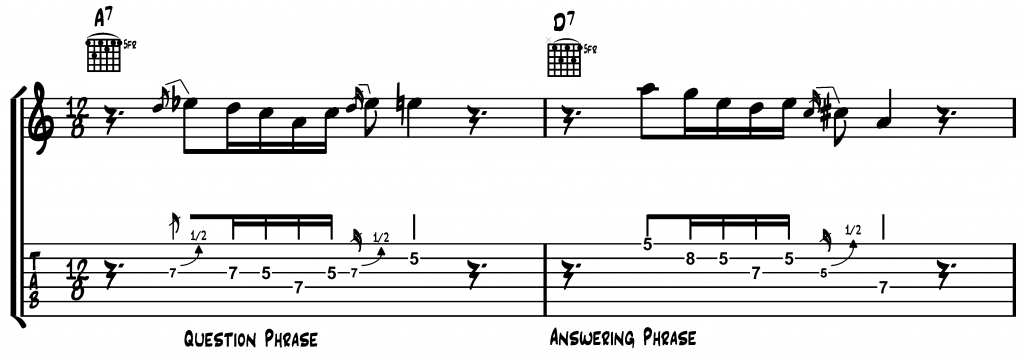
Obviously this is just one possible answering phrase, but I encourage you to play through many choruses of the blues and stick to answering the question with exactly the same rhythm but with many different melodies.
Next, how about using the same rhythm for your answer but displacing it earlier or later by one or more 1/18th notes?
This example shows an answer that is one 1/8th note early.
Example 4d:
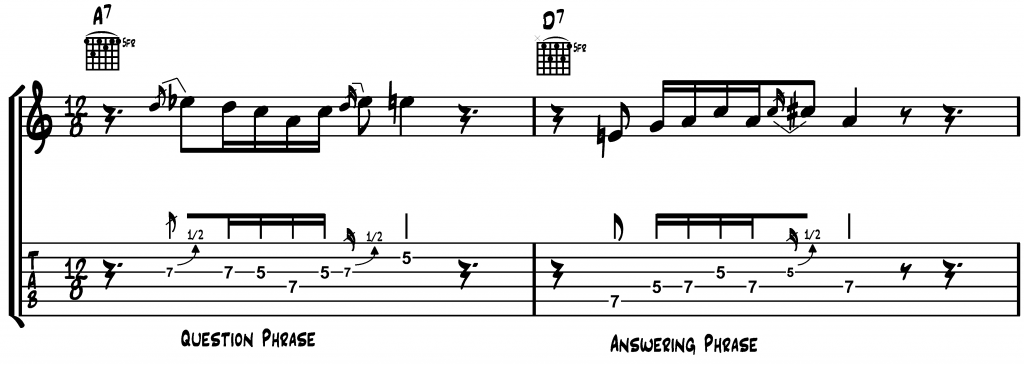
Here is just one example where we use the same rhythm starting one 1/8th note later.
Example 4e:
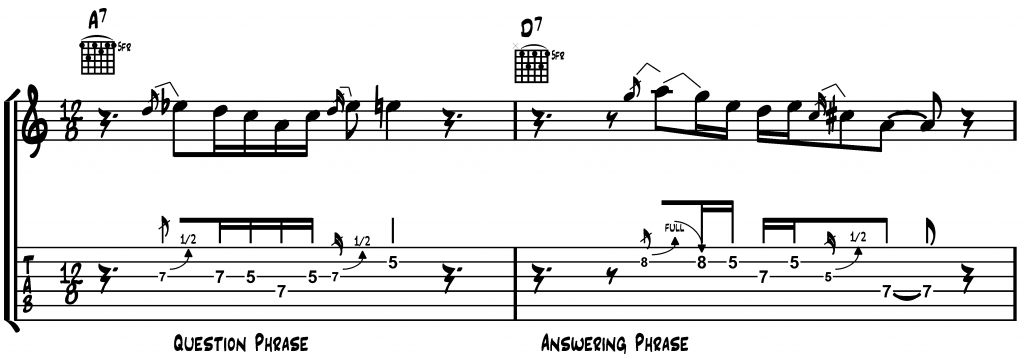
As you can see, the rhythm is identical but it starts one 1/8th note later and uses different notes.
Try to see if you can find ten different answering phrases beginning on beat two, then one 1/8th note early and finally one 1/8th note late. This is difficult but the idea is to force you to come up with new music on the spot. These exercises do get easier over time.
When you feel you have exhausted all your possibilities try beginning your answering phrase two 1/8ths earlier or later while still sticking to the same rhythm.
If I was to write out even just a few possible answers here for each displacement I would fill the book so it’s up to you to get creative.
Do you remember how displacing a lick in chapter three completely altered the phrase’s meaning and line that you were inspired to play after it? When you get tired of the previous exercises, try moving the question phrase an 1/8th note early or late and see how this effect your answer.
Example 4f: (Early)
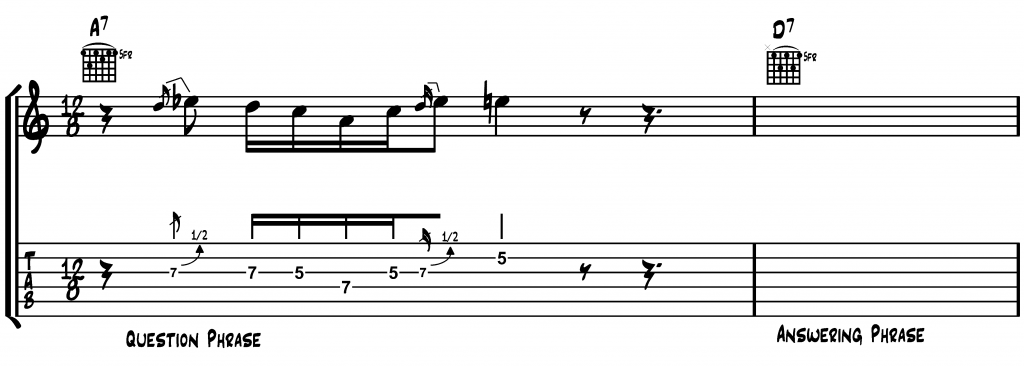
Example 4g: (Late)
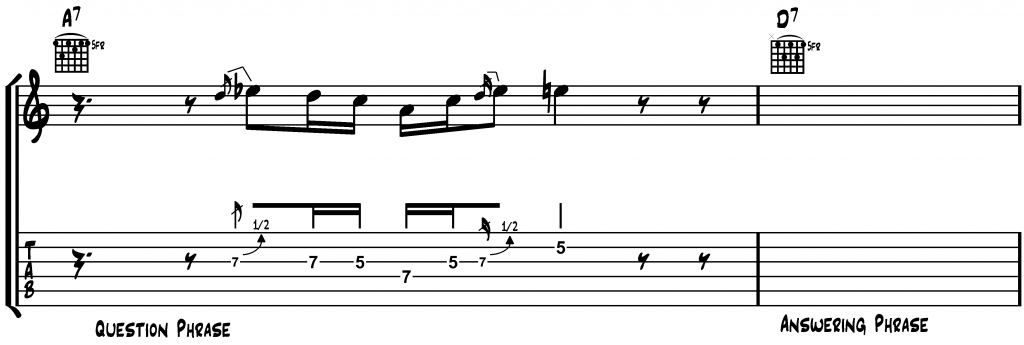
You have been locked into this rhythmic format for a while so now try allowing yourself to freely improvise an answer to the set question. You don’t have to worry about keeping the same rhythm; just see what comes out.
After a few days of this kind of playing you will find that you’re playing ideas spontaneously that you would never have thought possible.
Each day improvise a new melodic question and see how many ways you can find to answer it.
Try working with another musician and ask them to give you a completely different question every two bars and work on improvising answers.
This lesson is an extract from The Complete Guide to Blues Guitar Book Two: Melodic Phrasing.
“The artists you work with, and the quality of your work speaks for itself.”
Tommy Emmanuel
© Copyright Fundamental Changes Ltd 2025
No.6 The Pound, Ampney Crucis, England, GL7 5SA

